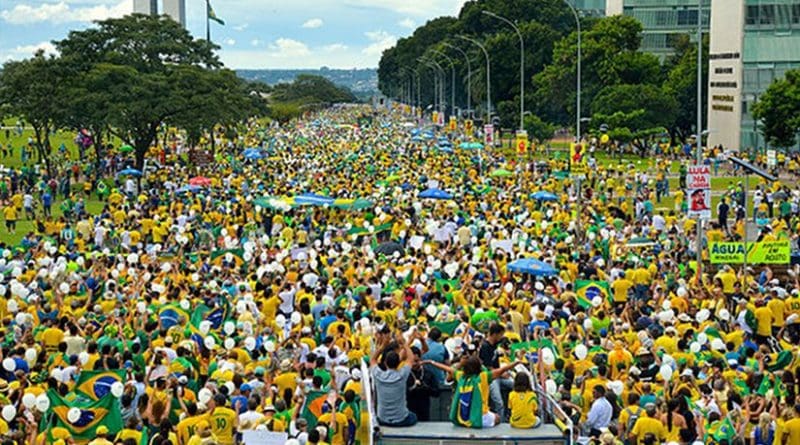Overview Of Class Struggle – OpEd
By James Petras
The class struggle from below has taken different forms and directions, with greater or lesser intensity, between countries and within countries in different time periods.
In general terms the countries with relative higher levels of urbanization and industrialization, experience the greatest urban centered struggles – as is the case with Argentina, Venezuela and Chile but not Brazil and Mexico.
Among the urban based class struggles, there is a further distinction between factory-based class struggles based on workers’ strikes (Argentina) and mass street action in the form of marches (Venezuela and Chile).
Urban based class struggles rely on coalitions of diverse classes, with distinct segments of the popular classes. For example in Argentina, pensioners, human rights groups and of late small and medium sized businesspeople have joined the class struggle around diverse issues ranging from soaring unemployment, reductions of pensions and wages and astronomical increases of the tariff on utilities.
Chile in contrast, experiences mass struggles including indigenous people, university, technical and high school students and popular community based movements with unionized teachers and medical personnel.
The Venezuelan urban class struggles are largely community based mobilizations in support of the government, and its social welfare program and in opposition to US backed coups.
Brazil is highly urbanized, yet in recent decades, the class struggle has revolved around the land occupation movements led by the rural landless movement (MST). To the extent that urban struggles play a role they revolve around the ‘homeless peoples movements’ and popular protests against public services . The urban industrial workers which played a leading role in the 1980’s and 90’s evolved into ‘corporate relations’ with the urban political elites and the center-left Workers’ Party.
The major class struggles in Paraguay, Peru and Mexico form a distinct cluster; Paraguay’s class struggles are predominantly led by rural-peasant movements linked to the demand for land reform and rely on direct action – land occupations and marches in the provincial and state capitals. The sharing of ethnic-class identity (Guarani speaking peasants in Paraguay) fortifies class solidarity as is the case in Peru among the Quechua and Aymara peasants.
The class struggle in Peru has centered in the provincial and regional areas. The centerpiece has been peasant and provincial communities struggling against dispossession by foreign owned mining conglomerates. In their struggle, mining workers’ trade unions, at best, play an auxiliary or secondary role. The community based struggles are local and multi-sectoral, as mining exploitation pollutes water, air, land, food and undermines local commerce – thus unifying a broad spectrum of otherwise ‘intermediary classes’. The urban working classes have offered symbolic support but have yet to become the protagonists that they were in the 1970’s and 80’s.
Mexico is the country with the greatest variety and volume of class struggles in Latin America, but the country with the least popular impact on the political elite. A key problem with the class strugle in Mexico is its dispersal – it is regional, sectoral and politically fragmented. Mexican authorities and their narco-death squads are notorious for assassinating emergent class based opposition: the most flagrant case is the murder of 43 rural students attending a teachers college. The range of militant groups include mining workers, teachers in Oaxaca, peasants in Guerrero, Indians in Chiapas and the national electrical workers union, which was severely repressed.
In terms of social welfare the class struggle has advanced furthest in Venezuela, largely under the political direction of Hugo Chavez. However, the precarious dependent state of the oil economy and the top down leadership precluded a sustainable social transformation. The most advanced land-reform struggles occurr in Brazil where the MST was able to occupy, transform and produce, settling over 300,000 families in expropriated farming estates in over two decades. Sustainable advances by the MST reflected its cohesive organization and broad social alliances in civil society.
The advance of the class struggle in Paraguay and Peru has linked land, environmental and indigenous movements in concerted and combatative struggles,which apply massive pressure to secure incremental gains, from the formidable ruling class bloc of local oligarchs, foreign multinationals and US military advisers.
Argentina’s formidable trade unions in industry, services and transport have repeatedly demonstrated their capacity to successfully convoke general strikes over wages and employment. Yet their hierarchical structure and bureaucratic leaderships preclude structural changes. Only in times of systemic crises – as in 2001-2003 – when a massive movement of unemployed workers took to the streets and ousted a series of Presidents, was there a serious struggle that demanded structural changes.
A comparable analysis of case studies of seven countries reveals a veritable mosaic of differences and similarities of class struggle in Latin America. The tempo and intensity of class struggle has shifted: in times of crises formidable popular advances occur; in other timeswhen economic reversal occur under center-left electoral regimes the ruling classes have led counter-reform regimes. Given the structural failures of the ruling classes and the legacy of class struggle from below, the reality is that any ‘rightist return’ is tenuous, unsustainable and reversible.

